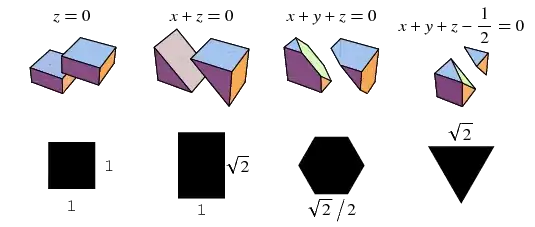Consider a unit hypercube of M dimensions. We wish to make a cut of dimension N through it. What is the largest N-D size (length, area, volume, ...) we can achieve, $S(M, N)$, and what cut gives it?
Examples:
- $S(M=2, N=1) = \sqrt2$
- Linear cut through a square
- Largest slice is the diagonal
- Length $\sqrt{1^2 + 1^2}$
- $S(M=3, N=1) = \sqrt3$
- Linear cut through a cube
- Largest slice is the space diagonal
- Length $\sqrt{1^2 + 1^2 + 1^2}$
- $S(M=3, N=2) = \sqrt 2$
- Planar cut through a cube
- Largest slice is the plane through the diagonal

- Area $\sqrt 2 \cdot 1$
Bits of this function are easy to generalize: $$ S(M, N) = \left\{ \begin{array}{rl} \sqrt M & : N = 1\\ ? & : 1 < N < M\\ 1 & : N = M\\ 0 & : N > M\\ \end{array} \right. $$
Can we generalize for $N = 2, 3, ...$?